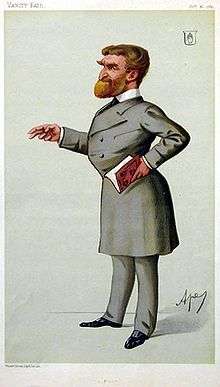Sir John Sinclair, 3rd Baronet
Sir John George Tollemache Sinclair, 3rd Baronet (8 November 1825 – 30 September 1912) was a Scottish landowner and Liberal politician who sat in the House of Commons from 1869 to 1885.

Sinclair as caricatured by Ape (Carlo Pellegrini), October 1880
Early life and education
Born in Edinburgh in 1825, he was the son of Sir George Sinclair, 2nd Baronet, and Lady Catherine Camilla Tollemache, daughter of William Talmash, Lord Huntingtower. He was a Page of Honour for Queen Adelaide. He was educated at Cheam School and the University of Durham.[1]
Career
He served as a lieutenant in the Scots Fusilier Guards.[1]
In 1861 he was made Vice-Lieutenant for Caithness.[2]
Sinclair was elected Member of Parliament for Caithness in 1869 and held the seat until 1885.[3] His majority of 13 over the Conservative candidate at the 1874 election is one of the smallest on record.[4] At the 1885 General election, his son Clarence succeeded him as Liberal candidate, but was defeated by Gavin Brown Clark, the Crofters' Party candidate.
Title and family
Sinclair married Emma Standish, daughter of William Standish, Duxbury Park, Lancashire, and Cocken Hall, Durham in 1853.[5] The couple had two sons and two daughters:
- Clarence Granville Sinclair (3 April 1858 – 16 November 1895), father of Archibald Sinclair
- George Felix Standish Sinclair JP (11 January 1861 – 10 June 1943)
- Amy Camilla Sinclair (died 27 February 1925)
- Nina Mary Adelaide Sinclair (1856 – 13 February 1924)[6]
In 1868 he succeeded his father to the baronetcy.
The marriage was dissolved in 1878.
He was succeeded in the baronetcy by his grandson Archibald Henry Macdonald Sinclair, later Viscount Thurso.
Miscellaneous
Sinclair was the earliest born person to have made a gramophone disc recording. He made titles for Columbia, Gramophone and Typewriter Ltd. and Odeon, all in 1906.[7] He also commissioned a statue of Mary, Queen of Scots, at 143–144 Fleet Street, London.[8]
Sources
- Who Was Who
- "Data on family". Archived from the original on 21 September 2007.
References
- Debrett's House of Commons. London: Dean. 1867. p. 210. LCCN 07024615.
- "No. 22504". The London Gazette. 23 April 1861. pp. 1754–1754.
- Leigh Rayment's Historical List of MPs – Constituencies beginning with "C" (part 1)
- "Smallest majorities at Westminster". Archived from the original on 28 September 2007. Retrieved 1 January 2008.
- "Index entry". FreeBMD. ONS. Retrieved 19 February 2013.
- "Index entry". FreeBMD. ONS. Retrieved 19 February 2013.
- "A Gallery of Documentary and Speech 78s". Archived from the original on 27 September 2007. Retrieved 1 January 2008.
- "Statue commissioned by Sinclair". Retrieved 1 January 2008.
External links
- Hansard 1803–2005: contributions in Parliament by Sir John Sinclair
- Works by or about Sir John Sinclair, 3rd Baronet in libraries (WorldCat catalog)
| Parliament of the United Kingdom | ||
|---|---|---|
| Preceded by George Traill |
Member of Parliament for Caithness 1869–1885 |
Succeeded by Gavin Brown Clark |
| Baronetage of Great Britain | ||
| Preceded by Sir George Sinclair |
Baronet (of Ulbster) 1868–1912 |
Succeeded by Sir Archibald Sinclair |